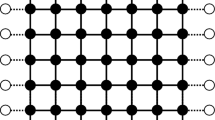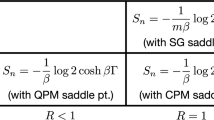Abstract
Recently, Baldwin and Swingle (J Stat Phys 190(7):125, 2023) considered spin glass models with additional conventional order parameters characterizing single-replica properties. These parameters are distinct from the standard order parameter, the overlap, used to measure correlations between replicas. A “min-max” formula for the free energy was prescribed in Baldwin and Swingle (2023). We rigorously verify this prescription in the setting of vector spin glass models featuring additional deterministic spin interactions. Notably, our results can be viewed as a generalization of the Parisi formula for vector spin glass models in Panchenko (Ann Probab 46(2):865–896, 2018), where the order parameter for self-overlap is already present.
Similar content being viewed by others
Data Availability
No datasets were generated during this work.
References
Agliari, E., Barra, A., Burioni, R., Di Biasio, A.: Notes on the p-spin glass studied via Hamilton-Jacobi and smooth-cavity techniques. J. Math. Phys. 53(6), 063304, 29 (2012)
Baldwin, C.L., Swingle, B.: Revisiting the replica trick: competition between spin glass and conventional order. J. Stat. Phys. 190(7), 125 (2023)
Barbier, J., Macris, N.: The adaptive interpolation method: a simple scheme to prove replica formulas in Bayesian inference. Probab. Theory Relat. Fields 174(3–4), 1133–1185 (2019)
Barbier, J., Macris, N.: The adaptive interpolation method for proving replica formulas. Applications to the Curie-Weiss and Wigner spike models. J. Phys. A 52(29), 294002 (2019)
Bardi, M., Evans, L.C.: On Hopf’s formulas for solutions of Hamilton-Jacobi equations. Nonlinear Anal. 8(11), 1373–1381 (1984)
Barra, A.: The mean field Ising model trough interpolating techniques. J. Stat. Phys. 132, 787–809 (2008)
Barra, A., Di Biasio, A., Guerra, F.: Replica symmetry breaking in mean-field spin glasses through the Hamilton-Jacobi technique. J. Stat. Mech. 2010(09), P09006 (2010)
Barra, A., Genovese, G., Guerra, F.: Equilibrium statistical mechanics of bipartite spin systems. J. Phys. A 44(24), 245002, 22 (2011)
Barra, A., Del Ferraro, G., Tantari, D.: Mean field spin glasses treated with PDE techniques. Eur. Phys. J. B 86(7), Art. 332, 10 (2013)
Barra, A., Di Lorenzo, A., Guerra, F., Moro, A.: On quantum and relativistic mechanical analogues in mean-field spin models. Proc. R. Soc. A 470(2172), 20140589 (2014)
Barra, A., Contucci, P., Mingione, E., Tantari, D.: Multi-species mean field spin glasses. Rigorous results. Ann. Henri Poincaré 16(3), 691–708 (2015)
Bates, E., Sohn, Y.: Free energy in multi-species mixed p-spin spherical models. Electron. J. Probab. 27, 1–75 (2022)
Bates, E., Sohn,Y.: Parisi formula for balanced Potts spin glass (2023). arXiv:2310.06745
Camilli, F., Contucci, P., Mingione, E.: An inference problem in a mismatched setting: a spin-glass model with Mattis interaction. SciPost Phys. 12(4), 125 (2022)
Chen, W.-K.: The Aizenman-Sims-Starr scheme and Parisi formula for mixed p-spin spherical models. Electron. J. Probab. 18, 1–14 (2013)
Chen, W.-K.: On the mixed even-spin Sherrington-Kirkpatrick model with ferromagnetic interaction. Ann. l’IHP Probab. Stat. 50(1), 63–83 (2014)
Chen, H.-B.: Hamilton-Jacobi equations for nonsymmetric matrix inference. Ann. Appl. Probab. 32(4), 2540–2567 (2022)
Chen, H.-B.: Self-overlap correction simplifies the Parisi formula for vector spins. Electron. J. Probab. 28, 1–20 (2023)
Chen, H.-B.: On the self-overlap in vector spin glasses (2023). arXiv:2311.09880
Chen, H.-B., Mourrat, J.-C.: On the free energy of vector spin glasses with non-convex interactions (2023). arXiv:2311.08980
Chen, H.-B., Xia, J.: Hamilton-Jacobi equations from mean-field spin glasses (2022). arXiv:2201.12732
Chen, H.-B., Xia, J.: Hamilton–Jacobi equations with monotone nonlinearities on convex cones (2022). arXiv:2206.12537
Chen, H.-B., Xia, J.: Hamilton-Jacobi equations for inference of matrix tensor products. Ann. Inst. Henri Poincaré Probab. Stat. 58(2), 755–793 (2022)
Chen, H.-B., Xia, J.: Free energy of multi-layer generalized linear models. Commun. Math. Phys. 1–53 (2023)
Chen, H., Mourrat, J.-C., Xia, J.: Statistical inference of finite-rank tensors. Ann. Henri Lebesgue 5, 1161–1189 (2022)
Dominguez, T., Mourrat, J.-C.: Statistical mechanics of mean-field disordered systems: a Hamilton-Jacobi approach (2023). arXiv:2311.08976
Genovese, G., Barra, A.: A mechanical approach to mean field spin models. J. Math. Phys. 50(5), 053303 (2009)
Guerra, F.: Sum rules for the free energy in the mean field spin glass model. Fields Inst. Commun. 30(11) (2001)
Guerra, F.: Broken replica symmetry bounds in the mean field spin glass model. Commun. Math. Phys. 233(1), 1–12 (2003)
Horn, R.A., Johnson, C.R.: Matrix Analysis. Cambridge University Press, Cambridge (2012)
Lions, P.-L., Rochet, J.-C.: Hopf formula and multitime Hamilton-Jacobi equations. Proc. Am. Math. Soc. 96(1), 79–84 (1986)
Mottishaw, P.: First-order spin glass transitions: an exact solution. Europhys. Lett. 1(8), 409 (1986)
Mourrat, J.-C.: Hamilton-Jacobi equations for finite-rank matrix inference. Ann. Appl. Probab. 30(5), 2234–2260 (2020)
Mourrat, J.-C.: Hamilton-Jacobi equations for mean-field disordered systems. Ann. H. Lebesgue 4, 453–484 (2021)
Mourrat, J.-C.: Nonconvex interactions in mean-field spin glasses. Probab. Math. Phys. 2(2), 281–339 (2021)
Mourrat, J.-C.: The Parisi formula is a Hamilton-Jacobi equation in Wasserstein space. Can. J. Math. 74(3), 607–629 (2022)
Mourrat, J.-C.: Free energy upper bound for mean-field vector spin glasses. Ann. Inst. Henri Poincaré Probab. Stat. 59(3), 1143–1182 (2023)
Mourrat, J.-C., Panchenko, D.: Extending the Parisi formula along a Hamilton-Jacobi equation. Electron. J. Probab. 25, 17 (2020)
Panchenko, D.: Free energy in the generalized Sherrington-Kirkpatrick mean field model. Rev. Math. Phys. 17(7), 793–857 (2005)
Panchenko, D.: The Sherrington-Kirkpatrick Model. Springer Monographs in Mathematics, Springer, New York (2013)
Panchenko, D.: The Parisi formula for mixed \( p \)-spin models. Ann. Probab. 42(3), 946–958 (2014)
Panchenko, D.: The free energy in a multi-species Sherrington-Kirkpatrick model. Ann. Probab. 43(6), 3494–3513 (2015)
Panchenko, D.: Free energy in the Potts spin glass. Ann. Probab. 46(2), 829–864 (2018)
Panchenko, D.: Free energy in the mixed \(p\)-spin models with vector spins. Ann. Probab. 46(2), 865–896 (2018)
Parisi, G.: Infinite number of order parameters for spin-glasses. Phys. Rev. Lett. 43(23), 1754 (1979)
Parisi, G.: A sequence of approximated solutions to the SK model for spin glasses. J. Phys. A 13(4), L115–L121 (1980)
Parisi, G.: Order parameter for spin-glasses. Phys. Rev. Lett. 50(24), 1946 (1983)
Rockafellar, R.T.: Convex Analysis, vol. 36. Princeton University Press, Princeton (1970)
Ruelle, D.: A mathematical reformulation of Derrida’s REM and GREM. Commun. Math. Phys. 108, 225–239 (1987)
Talagrand, M.: Free energy of the spherical mean field model. Probab. Theory Relat. Fields 134(3), 339–382 (2006)
Talagrand, M.: The Parisi formula. Ann. Math. (2) 163(1), 221–263 (2006)
Acknowledgements
The author thanks Jean-Christophe Mourrat for stimulating discussions. This project has received funding from the European Research Council (ERC) under the European Union’s Horizon 2020 research and innovation programme (Grant Agreement No. 757296).
Author information
Authors and Affiliations
Corresponding author
Ethics declarations
Conflict of interest
The author has no conflicts of interest to declare.
Additional information
Communicated by Federico Ricci-Tersenghi.
Publisher's Note
Springer Nature remains neutral with regard to jurisdictional claims in published maps and institutional affiliations.
Appendix A: Convergence of \(m_N\)
Appendix A: Convergence of \(m_N\)
As mentioned in Remark 1.4, we can show that \(m_N\) in (1.4) always converges under the Gibbs measure associated with \(F^{\textsf{soc}}_N\) in (1.2). When \(h=\textbf{s}\), we have that \(m_N = \frac{\sigma \sigma ^\intercal }{N}\) is the self-overlap and such a result has been proved in [19, Theorem 1.1 (1) and (2)]. A straightforward modification gives the desired result below.
Proposition A.1
Under conditions (H0)–(H4), if h is bounded and measurable, then \(m_N\) in (1.4) satisfies
where \(\mathscr {P}^h\) is defined in (2.4) and \(\left\langle \cdot \right\rangle \) is the Gibbs measure associated with \(F^{\textsf{soc}}_N\) in (1.2).
For completeness, we present the proof, which follows from the straightforward combination of the next two lemmas. We assume (H0)–(H4) henceforth.
Lemma A.2
Let \(\left\langle \cdot \right\rangle \) be associated with \(F^{\textsf{soc}}_N\). If h is bounded and measurable, then
Proof
Recall \(\mathcal {F}_N\) defined in (2.6). Let \(y\in \mathbb {R}^d\) and \(r>0\). The convexity of \(\mathcal {F}_N\) by Lemma 2.3 implies
Sending \(N\rightarrow \infty \) and then \(r\rightarrow 0\), and using Lemma 2.1 and the differentiability of \(\mathscr {P}^h\) in Lemma 2.2, we get
Varying y, we get \(\lim _{N\rightarrow \infty } \nabla \mathcal {F}_N(0,0) = \nabla \mathscr {P}^h(0)\) in \(\mathbb {R}^d\). Recall from (2.11) that \(\nabla \mathcal {F}_N(0,0) = \mathbb {E}\left\langle m_N\right\rangle \) where \(\left\langle \cdot \right\rangle \) is associated with \(\mathcal {F}_N(0,0)\). The desired result follows from the observation that \(\mathcal {F}_N(0,0)=F^{\textsf{soc}}_N\).
Lemma A.3
Let \(\left\langle \cdot \right\rangle \) be associated with \(F^{\textsf{soc}}_N\). If h is bounded and measurable, then
Proof
For \(x\in \mathbb {R}^d\), we write \(\mathcal {F}_N(x)=\mathcal {F}_N(0,x)\) (in (2.6)) for brevity. Let \(\left\langle \cdot \right\rangle _x\) be the Gibbs measure associated with \(\mathcal {F}_N(x)\). Since \(\mathcal {F}_N(0) = F^{\textsf{soc}}_N\), we have \(\left\langle \cdot \right\rangle =\left\langle \cdot \right\rangle _0\). Fix any \(y\in \mathbb {R}^d\) and set \(g(\sigma ) = Ny\cdot m_N = y\cdot \sum _{i=1}^Nh(\sigma _i)\). It suffices to show
Step 1. We show
We denote by \((\sigma ^l)_{l\in \mathbb {N}}\) independent copies of \(\sigma \) under the relevant Gibbs measure. Let \(r>0\). Integrating by parts, we get
The integrand in the last term can be estimated as follows
Inserting this into the previous display, we obtain
Setting \(\varepsilon _N = \frac{1}{N} \int _0^r \mathbb {E}\left\langle \left|g\left(\sigma \right) -\left\langle g\left(\sigma \right)\right\rangle _{sy}\right|^2\right\rangle _{sy}\textrm{d}s\), we can rewrite the above estimate as
Using (2.8), we have
for any \(t>0\), where the last inequality follows from the convexity of \(\mathcal {F}_N\) given by Lemma 2.3. Combining the above two displays, using Lemma 2.1, and noticing \(\sup _N\varepsilon _N<\infty \) (due to (2.5)), we obtain
We first send \(r\rightarrow 0\) and then \(t\rightarrow 0\). Since \(\mathscr {P}^h\) is differentiable by Lemma 2.2, the right-hand side vanishes, which yields (A.3).
Step 2. We show
Recall \({\widetilde{\mathcal {F}}}_N\) below (2.6) and we write \({\widetilde{\mathcal {F}}}_N(\cdot )= {\widetilde{\mathcal {F}}}_N(0,\cdot )\) for brevity. We can use (2.11) to rewrite
For \(r\in (0,1]\), we define
In view of (2.12), \({\widetilde{\mathcal {F}}}_N\) is convex, which implies that \(y\cdot \nabla {\widetilde{\mathcal {F}}}_N(0) - y\cdot \nabla \mathcal {F}_N(0)\) is bounded from above by
and from below by
By the standard concentration result (e.g. see [40, Theorem 1.2]), there is a constant \(C>0\) such that \(\sup _{r\in (0,1]}\mathbb {E}\delta _N(r)\leqslant CN^{-\frac{1}{2}}\). This along with Lemma 2.1 and (A.1) gives
Sending \(r\rightarrow \infty \), using the differentiability of \(\mathscr {P}^h\), and inserting this to (A.5), we get (A.4).
In conclusion, (A.2) follows from (A.3) and (A.4) and thus the proof is complete.
Rights and permissions
Springer Nature or its licensor (e.g. a society or other partner) holds exclusive rights to this article under a publishing agreement with the author(s) or other rightsholder(s); author self-archiving of the accepted manuscript version of this article is solely governed by the terms of such publishing agreement and applicable law.
About this article
Cite this article
Chen, HB. Free Energy in Spin Glass Models with Conventional Order. J Stat Phys 191, 49 (2024). https://doi.org/10.1007/s10955-024-03266-z
Received:
Accepted:
Published:
DOI: https://doi.org/10.1007/s10955-024-03266-z




